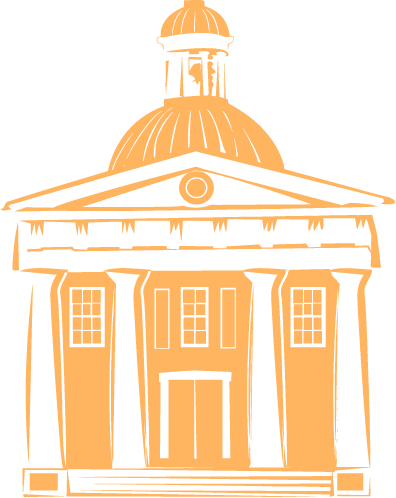The Neighborhood at a Glance
Diamond Hill lies to the south and west of Downtown with boundaries generally defined by steep terrain and ravines. Grace Street (formerly Campbell Courthouse Turnpike) and Washington Street are two major thoroughfares. First appearing in the 1820s, the naming of Diamond Hill is still a mystery. Theories include that the hill was named for wealthy residents, triangular shaped lots, or sparkling minerals in the soil.
Church Street between Twelfth and Thirteenth Streets looking towards Washington Street, ca. 1870. The footbridge seen here provided the only direct access to downtown from Washington Street, 1856-1870. The City Armory is located along this section of Church Street today (in the foreground on the photo).
A Deep Divide
Outside of the City limits until 1870, the neighborhood had a number of early homes but was somewhat isolated by Horseford Creek and a deep ravine between Washington and Twelfth Streets. In the 1850s, the women of Diamond Hill asked City Council to build a bridge over the ravine. City Council refused, but the women raised the funds and built their own footbridge. In the 1870s, the ravine was filled in and the creek piped underground.
Max Guggenheimer, Jr., was a Jewish immigrant from Germany. He served in the Confederate Army, led many successful businesses in the Hill City, and served on City Council. His wife Bertha was an international philanthropist.
Prominent Families
With examples of Gothic Revival, Queen Anne, Italianate, and other architectural styles, Diamond Hill has some of the most architecturally interesting homes in Lynchburg. Prominent residents have included business owners such as the Kinnear, Guggenheimer, Gannaway, and Moore families. The Blackford family, many of whom were soldiers and authors, also had a home on Diamond Hill that was visited by General Robert E. Lee in 1868.
Diamond Hill Baptist Church, built 1888
Historic Buildings
Historic buildings on Diamond Hill include the Grace Street Fire Station, ca. 1873, and Diamond Hill Baptist Church, ca. 1888. The church is the second oldest African American church in the city. Rev. Dr. Virgil Wood was pastor of Diamond Hill from 1958 to 1963, and the church was a center for local civil rights activities during his tenure. Rev. Dr. Wood was a friend and colleague of Rev. Dr. Martin Luther King, Jr., whom he brought to Lynchburg in 1962.
Two Hospitals
Marshall Lodge Memorial Hospital, built ca.1888. Created by the Masons, it was first called “Home and Retreat for the Sick and Wounded.”
Guggenheimer Health & Rehabilitation Center, 2016 The 1852 home is now part of the complex.
Two hospitals once stood along Grace Street. Marshall Lodge Memorial Hospital opened in 1886 and closed in 1971. In 1931 the Guggenheimer family home became Guggenheimer Memorial Hospital. Today it is a rehabilitation facility owned by Centra.






